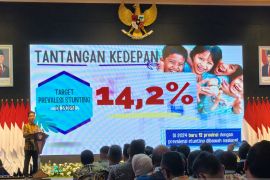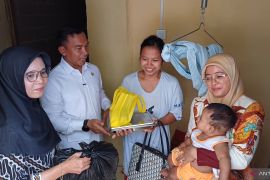“The term ‘dream team’ reflects our spirit of working together to address stunting, even if the effort may not be perfect,” he said on Wednesday after opening a basic training program for prospective civil servants in Jakarta.
Wihaji, who also heads the National Population and Family Planning Agency (BKKBN), said his ministry will focus on addressing the root causes of stunting, including access to clean water, sanitation, and adequate nutrition for pregnant women, breastfeeding mothers, and toddlers.
To address nutrition issues, the ministry is partnering with the National Nutrition Agency (BGN) through the Free Nutritious Meals (MBG) program.
Wihaji explained that his ministry will contribute human resources, gather data on MBG beneficiaries, and assist with food distribution, while BGN will be in charge of preparing nutritious meals.
He emphasized that efforts to reduce stunting will become more targeted and effective through stronger institutional collaboration this year, particularly by optimizing the MBG program.
“Soon, roles and responsibilities will be clearer — who does what and where. Our ministry will handle data collection, food distribution, and program evaluation. This is also the only program of its kind in the world,” he noted.
Earlier, in a working meeting with Commission IX of the Indonesian House of Representatives (DPR) on Tuesday, Wihaji said the ministry is prioritizing support for 1.4 million families at risk of stunting in the country’s lowest income bracket — the bottom 10 percent, known as decile 1.
“Based on our family information system, there are 42 million fertile couples, and 8.6 million families are considered at risk of stunting. Of these, 1.4 million belong to the decile 1 group. Addressing this is a priority,” he told lawmakers.
Beyond nutrition, Wihaji said that proper sanitation and habitable housing are also crucial in reducing stunting rates. Among the 8.6 million families at risk, 3.7 million do not have access to proper toilets, 1.9 million lack safe drinking water, and 4.3 million fertile couples face high-risk pregnancies and do not use modern contraception.
He explained that the four types of high-risk pregnancies include those occurring at a very young age (under 20), at an older age (over 35), with intervals of less than two years between pregnancies, and in women who have had more than four pregnancies.
Related news: RI Govt targets stunting risk in 1.4 million families
Related news: Indonesia pushes nutrition aid for pregnant women to cut stunting
Translator: Martha Herlinawati Simanjuntak
Editor: Anton Santoso
Copyright © ANTARA 2025












